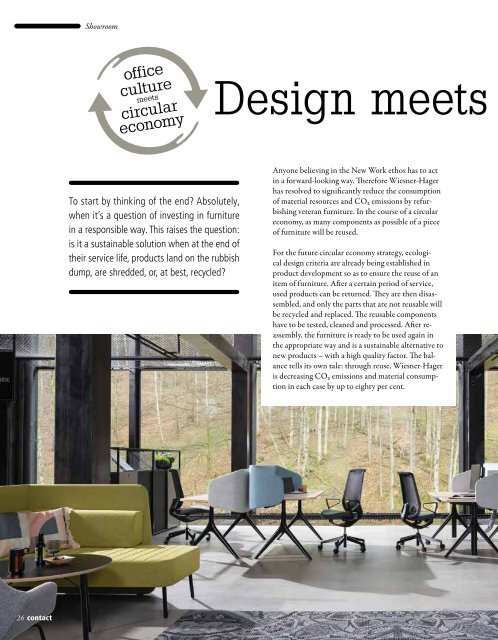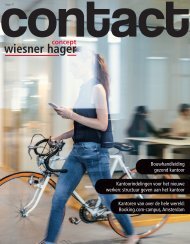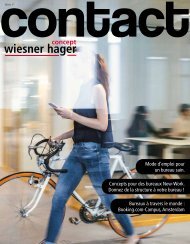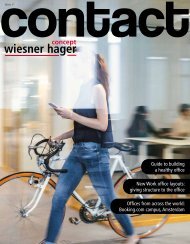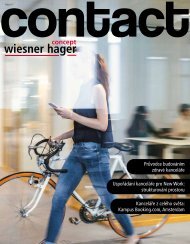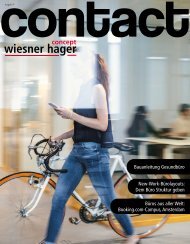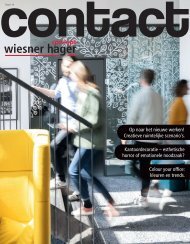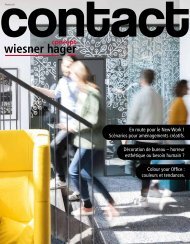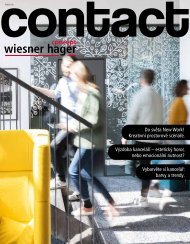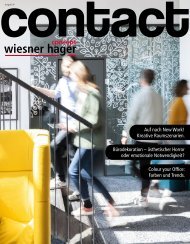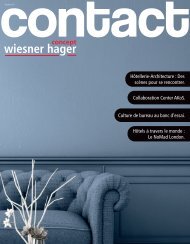contact_magazine_#36_EN
The way from the traditional office to the New Work office has turned out to be the hottest challenge of today. Traditional mindsets regarding organisation and leadership are a thing of the past. Joining forces with the architect Martin Thörnblom, an expert for innovative office concepts, we’ve booked a discovery trip to New Work and composed the title story based on the valuable experiences made on the journey.
The way from the traditional office to the New Work office has turned out to be the hottest challenge of today. Traditional mindsets regarding organisation and leadership are a thing of the past. Joining forces with the architect Martin Thörnblom, an expert for innovative office concepts, we’ve booked a discovery trip to New Work and composed the title story based on the valuable experiences made on the journey.
- No tags were found...
You also want an ePaper? Increase the reach of your titles
YUMPU automatically turns print PDFs into web optimized ePapers that Google loves.
Showroom<br />
Design meets circular economy.<br />
To start by thinking of the end? Absolutely,<br />
when it’s a question of investing in furniture<br />
in a responsible way. This raises the question:<br />
is it a sustainable solution when at the end of<br />
their service life, products land on the rubbish<br />
dump, are shredded, or, at best, recycled?<br />
Anyone believing in the New Work ethos has to act<br />
in a forward-looking way. Therefore Wiesner-Hager<br />
has resolved to significantly reduce the consumption<br />
of material resources and CO₂ emissions by refurbishing<br />
veteran furniture. In the course of a circular<br />
economy, as many components as possible of a piece<br />
of furniture will be reused.<br />
For the future circular economy strategy, ecological<br />
design criteria are already being established in<br />
product development so as to ensure the reuse of an<br />
item of furniture. After a certain period of service,<br />
used products can be returned. They are then disassembled,<br />
and only the parts that are not reusable will<br />
be recycled and replaced. The reusable components<br />
have to be tested, cleaned and processed. After reassembly,<br />
the furniture is ready to be used again in<br />
the appropriate way and is a sustainable alternative to<br />
new products – with a high quality factor. The balance<br />
tells its own tale: through reuse, Wiesner-Hager<br />
is decreasing CO₂ emissions and material consumption<br />
in each case by up to eighty per cent.<br />
furniloop:<br />
Office Culture meets Circular Economy.<br />
The new approach based on the circular economy<br />
strategy is already being implemented in one of this<br />
year’s new products by Wiesner-Hager. The name<br />
alone of the office desk programme – furniloop –<br />
stands for the product cycle and its components.<br />
The desk programme consists of four different<br />
frame types: symmetrical and asymmetrical frame,<br />
optionally electrical and mechanical height adjustment.<br />
The electrical adjustment version complies<br />
ideally with the need for ergonomic workplaces: the<br />
frequent change of position between dynamic sitting<br />
and standing relieves the spine and relaxes the back<br />
muscles.<br />
Screening also plays a key role here. The fabric-covered<br />
screen panel, suitable for pinning, is available in<br />
two heights and screens off the work space on three<br />
sides. This fosters peace and quiet and creates a sphere<br />
of privacy, especially as the panel, made of recycled<br />
polyester fibre, is superlatively sound-insulating.<br />
Besides the purely functional aspects, the screen also<br />
acts as a striking design element, imparting to the<br />
desk an individual aura. In addition, the screen can<br />
be shifted back, facilitating a simple and unobtrusive<br />
cable arrangement between the rear of the desktop<br />
and the screen panel.<br />
While materials like plastic are avoided because they<br />
do not fulfil the criteria for potential reuse, the option<br />
of a desktop of solid oak heralds a solution that<br />
is sustainable, emission-free and of high quality.<br />
Design: neunzig° design<br />
26 <strong>contact</strong><br />
<strong>contact</strong> 27


